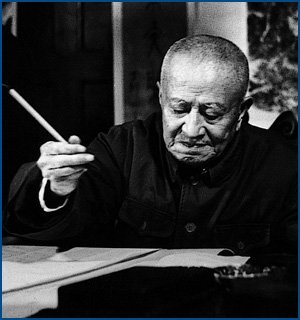Lin Sanzhi (1898 – 1989), a native of Anhui province, was born in Jiangpu of Jiangsu Province. His name was originally Yilin, but later changed to Sanzhi. He became a famous calligrapher very late in life, but his calligraphic works gained attention and growing reputation as time passed.
Lin had always loved drawing since he was young. His father passed away when he was 14 years old. At 13, he was introduced to learn ‘realistic brushwork figure painting’ from Zhang Qingpu in Nanjing, which provided him a very strong foundation in basic brushwork techniques. At 16, he learned Chinese calligraphy from his townsman Fan Peikai. Fan taught him the An Wu’s brushwork techniques of ‘double hook with suspended wrist’ and ‘perpendicular brush with centred-tip’, thus laid a strong foundation in calligraphy. 30 years later, Zhang Li-an, a scholar from Han San, introduced him to Huang Binhong in Shanghai, and from Huang, he fully mastered the secret of Hang’s famous ‘five writing and seven ink’ method of using brsuh. In 1933, taking instruction from Huang that one must travel ten thoudand miles while reading ten thoudsand books, he started his travel of ten-thousand miles, and the travel had influenced greatly his life.
Later, Lin recounted his learning journey last: ‘I began to learn Tang Dynasty stone tablet calligraphy when I was 16, and 30 years later, I learned the running script of Mi Fu. At the age of 60, I started to learn the cursive script. My cursive script was based on that of Wang Xizhi, and practiced on Monk Huai Su’s model works. I treated Wang Duo as my friend, Dong Qichang and Zhu Xizhe as my guests. My first teacher was Mr Fan. Later, Mr Zhang and Mr Huang perfected my skills. This is roughtly my learning journey of 80 years.’
Lin created his own cursive calligraphy writing style, paying great attention to brushstroke techniques. He preferred to use a writing brush made of goat's hair and his strokes were thin and of great strength, absorbing and capturing the essence of many ancient Chinese calligraphers. Lin used varied brushstrokes in calligraphic creation. Sometimes he wrote slowly and the strokes had a quiet and dignified beauty. At other times, he would write in a big rush and the strokes became straight and forceful. The varied brushstroke techniques in his works enabled him to form a magnificent and bold calligraphy style, which was of a great artistic appeal.
For his achievement, his was known as the sage of calligraphy of cursive writing.
.
林散之(1898一1989),安徽和县乌江镇人,生于江苏江浦。原名以霖,后改名散之。虽然是大器晚成,可是他的书法却随着时间的消失而益受瞩目与享有越来越高的声誉。
林散之童年即喜涂鸦。十四岁丧父。由人介绍,13岁到南京跟张青甫学习工笔人物画,练就基本功。十六岁随乡亲范培开先生学习书法。范先生授以安吴执笔之法,双钩悬腕,中锋竖管,打下了扎实的基础。三十以后,由含山进士张栗庵引荐,负笈沪上,拜黄宾虹为师,得“五笔七墨”之秘。一九三三年,遵黄老“读万卷书,行万里路”教导,开始影响一生的万里之行。
散之晚年历数自己学书历程道:“余十六岁始学唐碑,三十以后学行书,学米;六十岁以后学草书。草书以大王为宗,释怀素为体,王觉斯为友,董思白、祝希哲为宾。始启之者,范先生;终成之者,张师与宾虹师也。此余八十年学书之大略也。”
林散之自创自己的草体,注重笔法。他喜欢用羊毫笔,笔划瘦硬有力,融合古代不少书法家的精髓。林散之笔划变化多端。书写速度缓慢时,笔划静而优美;速度快时,笔划直而有力。不同的笔法使他能形成一种雄伟而大胆的书法风格,显示了强大的艺术魅力。
由于他的成就,他被称为当代草圣。
.






















No comments:
Post a Comment